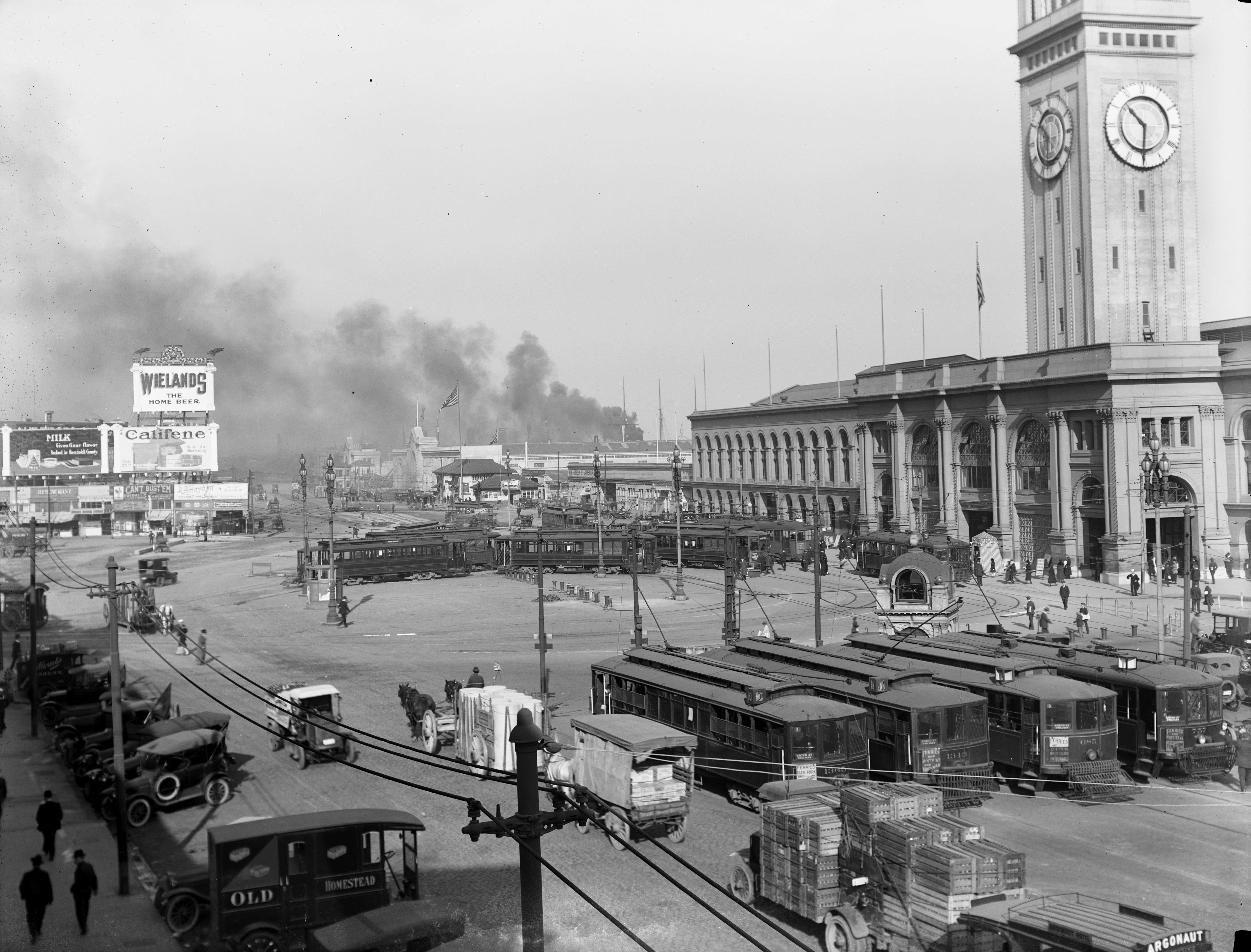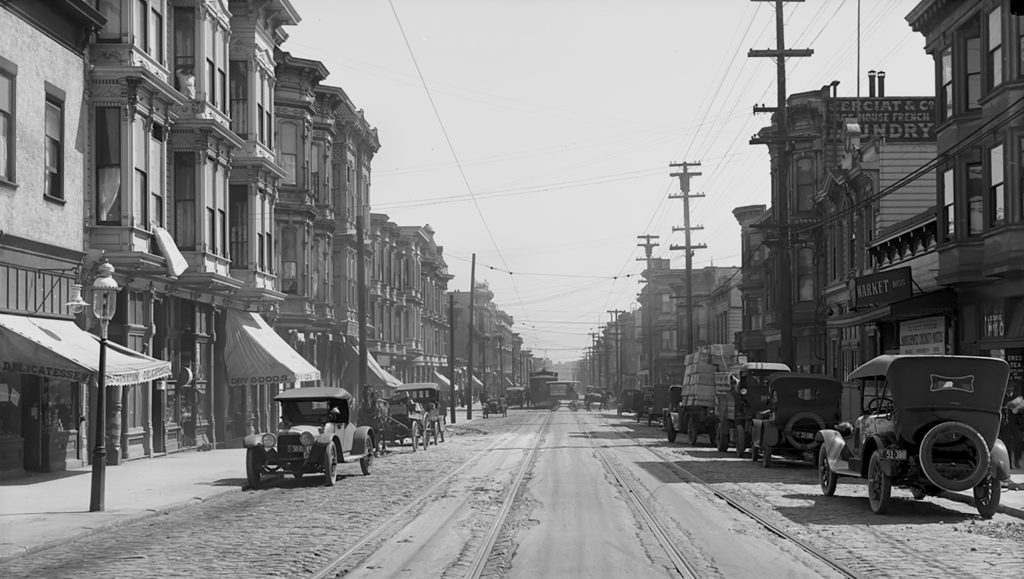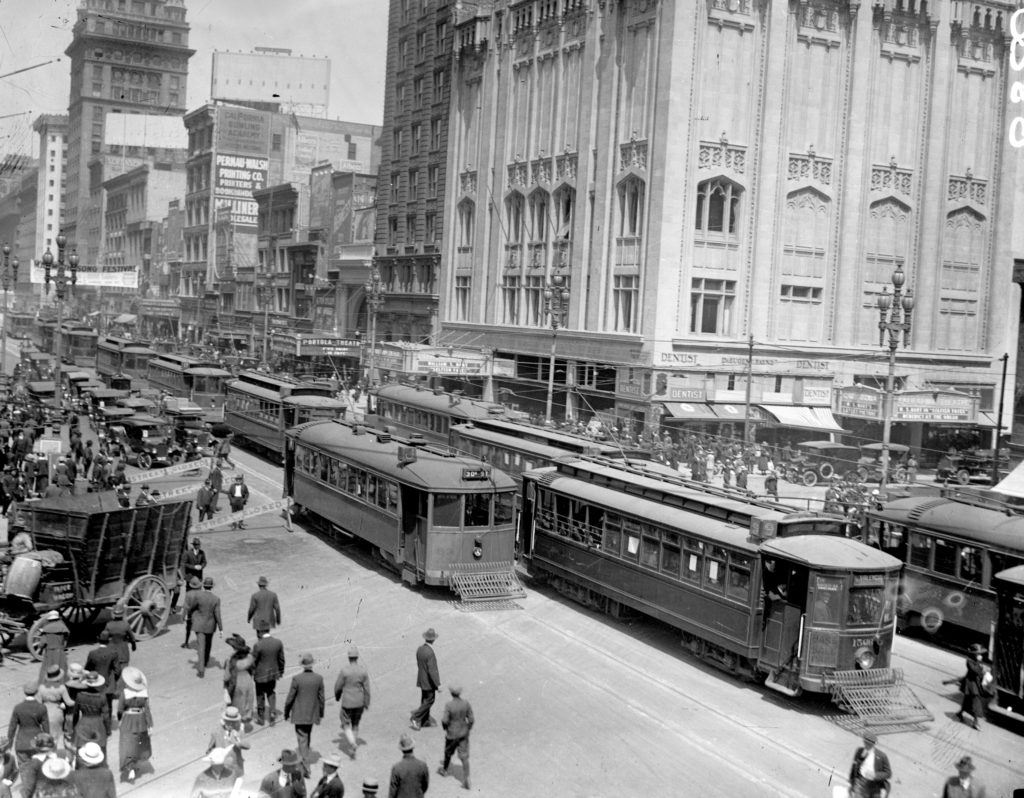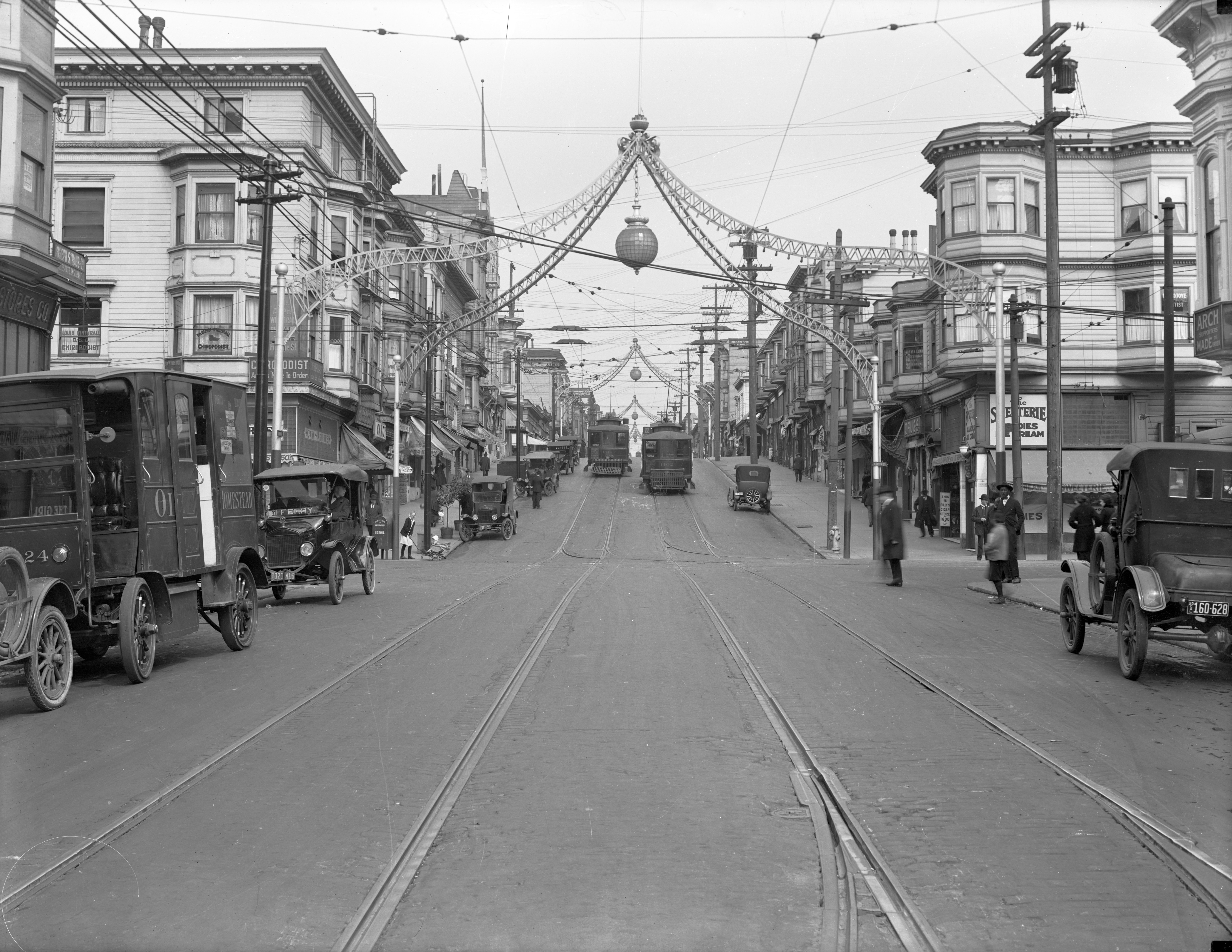Excerpted from a chapter in the forthcoming book by Emiliano Echeverria and Michael Dolgushkin, chronicling the complete history of San Francisco’s dominant transit operator for the first two decades of the 20th century.
At the turn of the twentieth century, San Francisco’s transit was coming of age. The Market Street Railway was in transition from being owned by interests in common with the Southern Pacific, to coming under the control of the partnership of Henry Huntington and I. W. Hellman: The Huntington – Hellman Syndicate. Management continued with Southern Pacific by mutual agreement. Things were going quite smoothly, indeed. Then everything changed.
In August 1900, the power behind everything connected with the Southern Pacific, and the Market Street Railway, Collis P. Huntington, died of heart failure. In the months just prior to his death, Collis P. Huntington had taken out large loans from the Speyer Brothers, which gave the investors of those loans “temporary” effective control of the Southern Pacific. Following Collis Huntington’s death, the Speyer Brothers had enough control to decide that they did not want “another Huntington” in the presidency of the Southern Pacific. With enough intrigue for a spy novel, they elected Arthur Hayes to the presidency of the Southern Pacific Company.
Henry Huntington, as a result, sold all his Southern Pacific stock holdings to investors who sold them to Edward H Harriman of the Union Pacific. Within a year Harriman would come to control the Southern Pacific. In addition to selling his holdings in the Southern Pacific, Huntington figured that it may be time to sell his interest in the Market Street Railway, as well. During the spring of 1901, he was noticing that a group of eastern investors were becoming more than casually interested in Bay Area transit systems. He decided that conversation with them may be opportune.

Eastern Investors, the Brown Brothers, Get Their Foothold
The group of “Eastern Capitalists,” The Brown Brothers, known locally as “The Baltimore Syndicate,” first entered the San Francisco transportation scene with the purchase of the San Francisco & San Mateo Electric Railway on May 12, 1901. This meant that the San Francisco & San Mateo Railway was the founding basis for URR, not the Market Street Railway which was several months later. The following July 1 the Syndicate bought the Sutter Street Railway, which included the two Richmond District lines purchased from the Sutro Railroad in 1899.
On July 11, 1901, the Market Street Railway President Henry Huntington and financier I. W. Hellman met with Baltimore Syndicate representative George R. Webb who began negotiations toward purchase, along with California State Attorney General Tirey L. Ford and San Francisco mining operator R. G. Hanford representing the Syndicate.
The agreements were announced in the press on November 7, 1901, and the Market Street Railway’s operating assets were transferred to the new United Railroads of San Francisco on March 18, 1902. Market Street Railway was reorganized by I.W. Hellman as a holding corporation handling the financial obligations of both the Market Street Railway and the United Railroads, particularly its bonded indebtedness.
Brown Brothers representative Arthur Holland became president of United Railroads. George F. Chapman was appointed General Manager on May 22. It soon became obvious that the Baltimore Syndicate had paid far too much for the property, somewhere in the neighborhood of 35 to 40 million dollars. This overvaluation proved an untenable situation for the company and plagued it throughout its existence.
It soon also became apparent that Patrick Calhoun of the United Railways investment Company, URR’s largest individual stockholder, acted as the power behind the scenes. Indeed, Calhoun was sent to San Francisco in 1903 to mediate the company’s dispute with the carmen’s union, a situation which prompted a news reporter to ask President Holland who was actually running the company.
The Brown Brothers Get Cold Feet: Ladenburg-Thalmann and The Rise of Patrick Calhoun
By April of 1905 the Brown Brothers had realized the futility of making a profit from a transit operation with overly watered stock, franchises of limited duration, and an only partially modernized system; and began negotiations to sell their interests in the United Railways Investment Company including its subsidiary United Railroads to the merchant banking firm of Ladenburg, Thalmann and Company.
In November Calhoun was back in San Francisco ostensibly for the purpose of attempting to negotiate a solution to the question of overhead trolley wires on Market and Sutter Streets, a matter which had been stewing all year. A few days later, on November 23, Arthur Holland announced his resignation as president of United Railroads, citing the Brown Brothers desire to withdraw from management of the company. Calhoun’s presence in San Francisco at the time Ladenburg, Thalmann & Company was taking over management can hardly be seen as a coincidence and, indeed, he was elected president of United Railroads on December 30, 1905. Among other factors, the new ownership and Calhoun’s ascendancy resulted in a much less friendly attitude toward organized labor. Calhoun, after a lengthy stay in New York, returned to San Francisco on March 12 to deal with proposed improvements to the United Railroads system and the perennial overhead trolley issue.

Everything Changes
The great earthquake and fire of April 18-21, 1906 stopped United Railroads operations – cold, although cars began running on Fillmore Street the night of the 21st. Company headquarters moved temporarily to the Turk and Fillmore Car-house. The Royal, New York Underwriters, and Phoenix Insurance Companies were named adjustors of United Railroads losses. As the city rebuilt the company’s route structure and methods of operation changed. A couple of months later URR set up a more substantial temporary headquarters at the location of the former Oak & Broderick Power House. Here, company management could function until a new headquarters was found at 58 Sutter, its permanent home.
Then, on March 10, 1907, the receivers of the Westinghouse Electric and Manufacturing Company joined other creditors (including General Electric and the Lorain Steel Company) in an adjustment of their claims against United Railroads, which had a floating indebtedness amounting to $3,500,000 and faced receivership. United Railways Investment Company agreed to issue notes in that amount to be secured by an issue of first preferred stock in United Railroads, to bear a 6 per cent interest, and be payable for the first half in August 1912, and the second half in February 1914. Patrick Calhoun blamed this situation on money lost during the recent strike, and said that the company was “cleaning up its finances.”
On May 5, 1907, the carmen went out on strike, during which United Railroads Vice President and General Manager George F Chapman passed away from pneumonia. After a brief interim tenure by Thornwell Mullaly, he was replaced as General Manager by Charles N. Black on September 11, 1907.
In December 1908, the United Railways Investment Company gained control of the Stanislaus Water Power Company, giving United Railroads not only abundant power for its lines but also a surplus of approximately 40,000 horsepower available for sale, saving the company $300,000 to $500,000.
Holding Companies Take Over Ownership
The Railroads and Power Development Company was formed on June 9, 1909, as a holding company which owned all stock, except directors’ qualifying shares of the United Railroads, San Francisco Electric Railways, Sierra and San Francisco Power Company, and Coast Valleys Gas and Electric Company. It also served the purpose of shielding United Railways Investment Company from United Railroads’ financial obligations.
The California Railway and Power Company was organized under the laws of Delaware on December 18, 1912, to acquire from The Railroads and Power Development Company all of the outstanding stock of the United Railroads of San Francisco, The San Francisco Electric Railway Company. Sierra and San Francisco Power Company, and Coast Valley Gas and Electric Company. All the issued common and preferred stock of California Railway and Power Company was owned by United Railways Investment Company. Ladenburg, Thalmann still retained some financial stake in United Railroads, but their influence immediately waned.

Patrick Calhoun Out, Jesse Lilienthal Ascends to the Presidency
On August 28, 1913, Patrick Calhoun resigned, and after a very brief tenure by Mason B. Starring, Jesse W. Lilienthal assumed the presidency of United Railroads.
Calhoun quit the United Railways Investment Company Board in April, 1914. The following month it was revealed that Calhoun had gotten permission by the United Railroads Board to purchase outside stock with company money, which he used instead to invest in the failed Solano Land Company to the tune of what was reported in the newspapers as $1,096,000 but was actually closer to $3,000,000. This sparked an investigation by the State Railroad Commission as to whether the money had been returned to United Railroads, and what the company intended to do if it hadn’t. Tirey L. Ford stated that he voted for the resolution but never heard the land company’s name mentioned. Lilienthal called the matter “ancient history,” and said he was not positive where the money was placed. He was supposedly unaware of the company’s financial state when he accepted the presidency, and said he would not have accepted it had he known. He also came under fire for his handling of his predecessor’s actions.
In 1916, during the midst of much corporate chaos, William Von Phul was appointed to succeed Charles N. Black as general manager of United Railroads on June 1, 1916. Not long afterwards a reorganization plan for the company was announced, which would involve a blanket mortgage for the entire property. The $1,000,000 United Railroads notes and the $1,925,000 California and Power notes would be taken care of by stock in the reorganized company. The outstanding $7,053,000 Market Street Railway 5s would receive par or 90. Bankers immediately began to express doubt over this arrangement, particularly if 4 per cent bonds could be placed at 50.
Not long after, the company’s bondholders invited Frank B. Anderson, William H. Crocker, Herbert Fleishhacker, I. W. Hellman, Jr., and J. D. McKee to form a new reorganization committee. About two weeks later the committee asked the four percent bondholders to deposit their securities with the Union Trust Company, hinting that the next coupons could not be paid unless the proposed organization could be consummated. Late in September the committee announced a plan in which the 4% bonds would get 25% in Market Street 5s and 46% in first preferred, wiping out $44,330,100 in URR’s liabilities.
Shortly thereafter, bankers revealed plans to pay URR bondholders 71 cents on the dollar, the company announced default on its October interest, and doubts were raised about whether the committee’s plan would do what was intended. In November, the Railroad Commission requested an inventory and appraisal of URR property, and the Baltimore Trust Company opposed the reorganization plan, asking for a better deal for its bondholders. By the end of the year a suit was brought by the Oakland Bank of Savings and D. A. Bulmore, along with the Anglo and London Paris National Bank, to foreclose the trust mortgage securing the outstanding $1,800,000 in outstanding Market Street Cable Railway bonds.
The United Railroads reorganization scheme, and opposition to it, dragged through the beginning of 1917, as clamor for purchase by the city increased. By the end of April the reorganization plans appeared to have been completed, with the bondholders to receive 66 2/3% of their holdings in new 6% bonds, 1% to 3% in new 6% first preferred stock, and 33% in new common stock. This seemed to satisfy everyone for the time being, but the issue was pushed to the back burner for the rest of the year by the United States entry into World War I, and the carmen’s strike (resulting in further agitation for municipal purchase). During this lull in negotiations, in October 1918, the California Railway and Power Company reported on its poor financial state, and blamed it primarily on the previous year’s strike.
The Reorganization Gets Back on Track
Early in 1919, the previously dormant reorganization plan was once again active, with Lilienthal explaining that the restructuring would be done in a way that would give a large margin between the expected earnings and the fixed charges, which would be accomplished by the holders of the United Railroads 4 per cent bonds taking junior securities in exchange, and that Ladenburg, Thalmann would accept junior securities of the reorganized company in exchange for the $5,000,000 obligation of the present one. The holders of the Market Street Cable 6s, the Ferries & Cliff House 6s, The Omnibus Cable Company 6s, and the Sutter Street Railway 5s, totaling $5,200,000, would receive par. Progress on this matter continued to be made into the next month, and its sinking fund 4 per cent bond certificates increased in value. However, Thornwell Mullally stepped down as assistant to the president of URR on February 25, 1919.
Although no one knew at the time, Jesse Lilienthal’s appointment as President of URR, like for George Chapman before him, would be the death of him. United Railroads President Jesse W. Lilienthal died of a stroke on June 3, 1919, as he was giving a speech at the Colonial Ballroom at the Hotel St. Francis, his last words being “In times like these we know no creeds. For the American of today there should be only this thought-one country, one flag, one God.” Lilienthal passed without having seen his desire for city purchase of the company come to fruition. William Von Phul took his place while also retaining the general manager position of United Railroads.
During the summer and fall of 1919, the United Railroads reorganization plans continued and were further amended. In August it was announced that 100 per cent of par would be offered, but with a reduced proportion of Market Street Railway bonds, and the balance made up in stock of all three issues. The following month came the news that the reorganization plans had been perfected. The United Railroads would cease to exist and the Market Street Railway Company, with a new $32,150,000 capitalization, would reacquire all the properties. A few days later the United Railroads bondholders were asked to deposit their securities with E. H. Rollins & Sons in return for five year 6 per cent notes. As of late November 1920, the plan had met with approval among the bondholders, but had not yet gone before the Railroad Commission for approval.

1920-21 – The Death of URR and the Rebirth of MSR
The petition for the United Railroads reorganization was not presented to the Railroad Commission until June 18, 1920, as clamor for city purchase persisted. The plan was formally submitted on September 10, with a reduction in the company’s capitalization from $81,945,600 to $47,516,000. The Railroad Commission approved the plan, and on January 29, 1921, the Union Trust Company began foreclosure proceedings against United Railroads, with the reorganization expected to take effect in 60 days. Those proceedings were temporarily halted on February 5, but were soon allowed to continue. The receiver’s sale took place on March 21, signaling the corporate end of United Railroads, and brought $7,000,000. Several steps remained to be taken, but on April 1, 1921 the Market Street Railway Company regained operation of most of San Francisco’s privately-owned street railway lines.